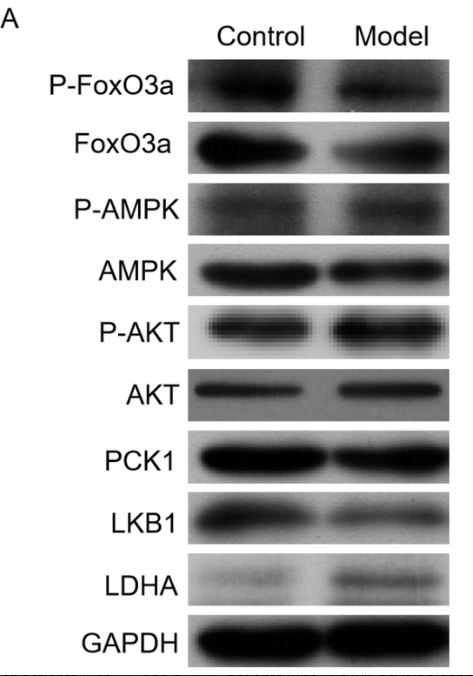产品描述
*The optimal dilutions should be determined by the end user.
*Tips:
WB: 适用于变性蛋白样本的免疫印迹检测. IHC: 适用于组织样本的石蜡(IHC-p)或冰冻(IHC-f)切片样本的免疫组化/荧光检测. IF/ICC: 适用于细胞样本的荧光检测. ELISA(peptide): 适用于抗原肽的ELISA检测.
引用格式: Affinity Biosciences Cat# DF6770, RRID:AB_2838732.
展开/折叠
cytosolic [GTP]; GTP; PCK1; PCKGC_HUMAN; PEP carboxykinase; PEPCK-C; PEPCK1; PEPCKC; Phosphoenolpyruvate carboxykinase 1 (soluble); Phosphoenolpyruvate carboxykinase 1; Phosphoenolpyruvate carboxykinase; Phosphoenolpyruvate carboxykinase, cytosolic [GTP]; Phosphoenolpyruvate carboxykinase, cytosolic; Phosphoenolpyruvate carboxylase; Phosphopyruvate carboxylase;
抗原和靶标
- P35558 PCKGC_HUMAN:
- Protein BLAST With
- NCBI/
- ExPASy/
- Uniprot
MPPQLQNGLNLSAKVVQGSLDSLPQAVREFLENNAELCQPDHIHICDGSEEENGRLLGQMEEEGILRRLKKYDNCWLALTDPRDVARIESKTVIVTQEQRDTVPIPKTGLSQLGRWMSEEDFEKAFNARFPGCMKGRTMYVIPFSMGPLGSPLSKIGIELTDSPYVVASMRIMTRMGTPVLEAVGDGEFVKCLHSVGCPLPLQKPLVNNWPCNPELTLIAHLPDRREIISFGSGYGGNSLLGKKCFALRMASRLAKEEGWLAEHMLILGITNPEGEKKYLAAAFPSACGKTNLAMMNPSLPGWKVECVGDDIAWMKFDAQGHLRAINPENGFFGVAPGTSVKTNPNAIKTIQKNTIFTNVAETSDGGVYWEGIDEPLASGVTITSWKNKEWSSEDGEPCAHPNSRFCTPASQCPIIDAAWESPEGVPIEGIIFGGRRPAGVPLVYEALSWQHGVFVGAAMRSEATAAAEHKGKIIMHDPFAMRPFFGYNFGKYLAHWLSMAQHPAAKLPKIFHVNWFRKDKEGKFLWPGFGENSRVLEWMFNRIDGKASTKLTPIGYIPKEDALNLKGLGHINMMELFSISKEFWEKEVEDIEKYLEDQVNADLPCEIEREILALKQRISQM
种属预测
score>80的预测可信度较高,可尝试用于WB检测。*预测模型主要基于免疫原序列比对,结果仅作参考,不作为质保凭据。
High(score>80) Medium(80>score>50) Low(score<50) No confidence
研究背景
Regulates cataplerosis and anaplerosis, the processes that control the levels of metabolic intermediates in the citric acid cycle. At low glucose levels, it catalyzes the cataplerotic conversion of oxaloacetate (OAA) to phosphoenolpyruvate (PEP), the rate-limiting step in the metabolic pathway that produces glucose from lactate and other precursors derived from the citric acid cycle. At high glucose levels, it catalyzes the anaplerotic conversion of phosphoenolpyruvate to oxaloacetate.
Acetylated. Lysine acetylation by p300/EP300 is increased on high glucose conditions. Lysine acetylation promotes ubiquitination by UBR5. Acetylation is enhanced in the presence of BAG6. Deacetylated by SIRT2. Deacetylation of Lys-91 is carried out by SIRT1 and depends on PCK1 phosphorylation levels.
Phosphorylated in a GSK3B-mediated pathway; phosphorylation affects the efficiency of SIRT1-mediated deacetylation, and regulates PCK1 ubiquitination and degradation.
Ubiquitination by UBR5 leads to proteasomal degradation.
Cytoplasm.
Major sites of expression are liver, kidney and adipocytes.
Monomer.
Belongs to the phosphoenolpyruvate carboxykinase [GTP] family.
研究领域
· Environmental Information Processing > Signal transduction > FoxO signaling pathway. (View pathway)
· Environmental Information Processing > Signal transduction > PI3K-Akt signaling pathway. (View pathway)
· Environmental Information Processing > Signal transduction > AMPK signaling pathway. (View pathway)
· Human Diseases > Endocrine and metabolic diseases > Insulin resistance.
· Metabolism > Carbohydrate metabolism > Glycolysis / Gluconeogenesis.
· Metabolism > Carbohydrate metabolism > Citrate cycle (TCA cycle).
· Metabolism > Carbohydrate metabolism > Pyruvate metabolism.
· Metabolism > Global and overview maps > Metabolic pathways.
· Organismal Systems > Endocrine system > PPAR signaling pathway.
· Organismal Systems > Endocrine system > Insulin signaling pathway. (View pathway)
· Organismal Systems > Endocrine system > Adipocytokine signaling pathway.
· Organismal Systems > Endocrine system > Glucagon signaling pathway.
· Organismal Systems > Excretory system > Proximal tubule bicarbonate reclamation.
文献引用
Application: IF/ICC Species: Mouse Sample:
Application: WB Species: mouse Sample: liver
Application: WB Species: Mouse Sample: gastric mucosa
Application: IF/ICC Species: Fish Sample:
限制条款
产品的规格、报价、验证数据请以官网为准,官网链接:www.affbiotech.com | www.affbiotech.cn(简体中文)| www.affbiotech.jp(日本語)产品的数据信息为Affinity所有,未经授权不得收集Affinity官网数据或资料用于商业用途,对抄袭产品数据的行为我们将保留诉诸法律的权利。
产品相关数据会因产品批次、产品检测情况随时调整,如您已订购该产品,请以订购时随货说明书为准,否则请以官网内容为准,官网内容有改动时恕不另行通知。
Affinity保证所销售产品均经过严格质量检测。如您购买的商品在规定时间内出现问题需要售后时,请您在Affinity官方渠道提交售后申请。产品仅供科学研究使用。不用于诊断和治疗。
产品未经授权不得转售。
Affinity Biosciences将不会对在使用我们的产品时可能发生的专利侵权或其他侵权行为负责。Affinity Biosciences, Affinity Biosciences标志和所有其他商标所有权归Affinity Biosciences LTD.







![Figure 6. Metabolomic comparison between control, 1,9-dideoxyforskolin (1,9-DDF), and carbonyl cyanide-p-trifluoromethoxyphenylhydrazone (FCCP) treatment. (A) Heatmap illustrating 29 statistically significant metabolite changes (parametric one-way ANOVA, Fisher’s LSD post hoc analysis). Three main clusters of metabolite changes were evident (dashed lines). (B) Immunostaining (green) for enzymes related to glutamine metabolism. DAPI (grey) was used as nuclear counterstain. (B1) Glutamine synthase (GS), (B2) glutaminase C (GAC); co-localisation with cone-arrestin (Arr3; magenta). (B3) Phosphoenolpyruvate carboxykinase 1 (PCK1) did not co-localise with cone marker peanut agglutinin (PNA) while (B4) PCK2 did. (C) Ratios between metabolites representing glycolysis (lactate vs. guanosine triphosphate [GTP]), anaplerotic metabolism (GTP vs. branched chain amino acids [BCAA]), and serine synthesis pathway (serine vs. lactate). Data represented as individual data points with mean ± SD (n=5). PCK1 Antibody - Figure 6.](http://img.affbiotech.cn/uploads/202407/56a13c74396defe95ef9f3aee5a771c3.png)